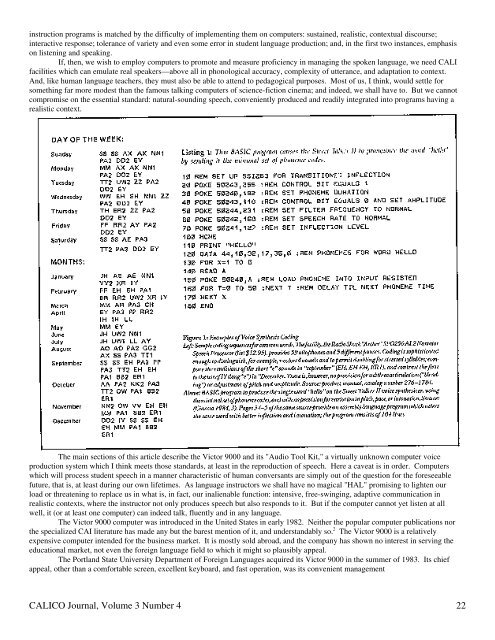MASTER (') S VOICE: THE VICTOR 9000 AND HIGH-FIDELITY ...
MASTER (') S VOICE: THE VICTOR 9000 AND HIGH-FIDELITY ...
MASTER (') S VOICE: THE VICTOR 9000 AND HIGH-FIDELITY ...
Create successful ePaper yourself
Turn your PDF publications into a flip-book with our unique Google optimized e-Paper software.
instruction programs is matched by the difficulty of implementing them on computers: sustained, realistic, contextual discourse;<br />
interactive response; tolerance of variety and even some error in student language production; and, in the first two instances, emphasis<br />
on listening and speaking.<br />
If, then, we wish to employ computers to promote and measure proficiency in managing the spoken language, we need CALI<br />
facilities which can emulate real speakers—above all in phonological accuracy, complexity of utterance, and adaptation to context.<br />
And, like human language teachers, they must also be able to attend to pedagogical purposes. Most of us, I think, would settle for<br />
something far more modest than the famous talking computers of science-fiction cinema; and indeed, we shall have to. But we cannot<br />
compromise on the essential standard: natural-sounding speech, conveniently produced and readily integrated into programs having a<br />
realistic context.<br />
The main sections of this article describe the Victor <strong>9000</strong> and its "Audio Tool Kit," a virtually unknown computer voice<br />
production system which I think meets those standards, at least in the reproduction of speech. Here a caveat is in order. Computers<br />
which will process student speech in a manner characteristic of human conversants are simply out of the question for the foreseeable<br />
future, that is, at least during our own lifetimes. As language instructors we shall have no magical "HAL" promising to lighten our<br />
load or threatening to replace us in what is, in fact, our inalienable function: intensive, free-swinging, adaptive communication in<br />
realistic contexts, where the instructor not only produces speech but also responds to it. But if the computer cannot yet listen at all<br />
well, it (or at least one computer) can indeed talk, fluently and in any language.<br />
The Victor <strong>9000</strong> computer was introduced in the United States in early 1982. Neither the popular computer publications nor<br />
the specialized CAI literature has made any but the barest mention of it, and understandably so. 2 The Victor <strong>9000</strong> is a relatively<br />
expensive computer intended for the business market. It is mostly sold abroad, and the company has shown no interest in serving the<br />
educational market, not even the foreign language field to which it might so plausibly appeal.<br />
The Portland State University Department of Foreign Languages acquired its Victor <strong>9000</strong> in the summer of 1983. Its chief<br />
appeal, other than a comfortable screen, excellent keyboard, and fast operation, was its convenient management<br />
CALICO Journal, Volume 3 Number 4 22
















